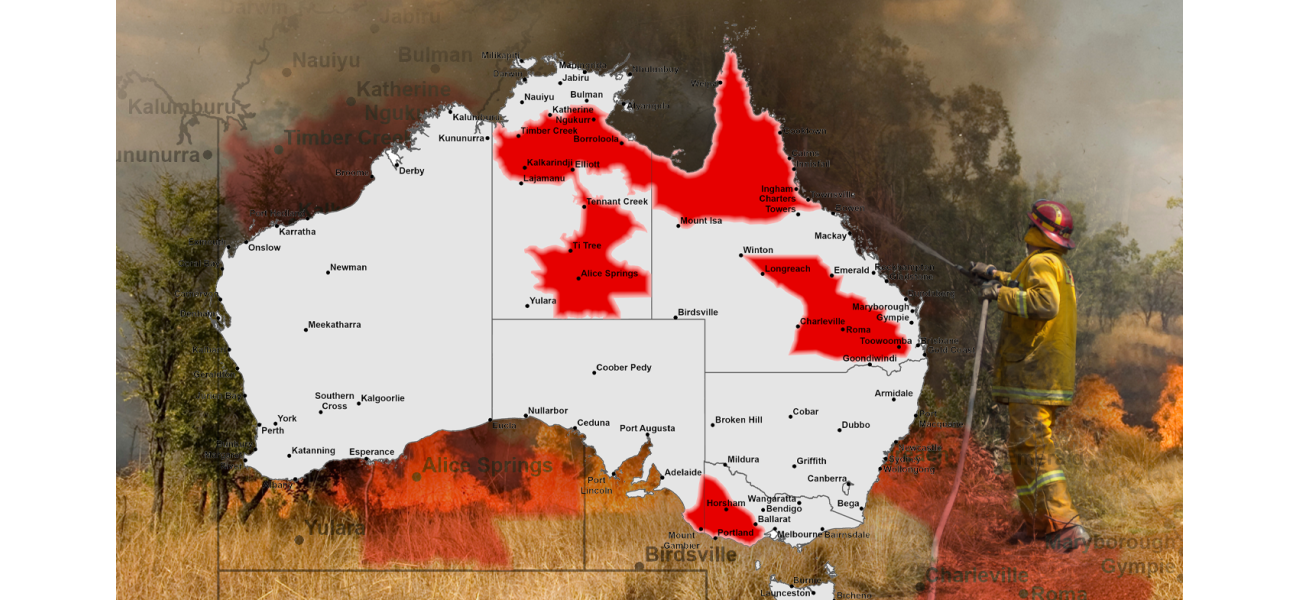Australian regions most threatened by wildfires this season.
Firefighters nationwide are on high alert due to record-breaking temperatures in August.
September 4th 2024.

As the days grow longer and the temperatures rise, it's becoming clear that spring has arrived in full force. However, along with the warm weather and gusty winds, comes an increased risk of bushfires in some parts of the country. The National Council for Fire and Emergency Services has just released their Seasonal Bushfire Outlook report, warning communities to be on alert as the weather heats up.
According to the report, large areas of Queensland, the Northern Territory, and western Victoria are at a higher risk of bushfires this spring. In fact, the recent record-breaking temperatures in August have raised concerns for the rest of the season. The above-average temperatures are expected to continue, making conditions perfect for fires to spread quickly.
Adding to the concern is the high levels of grass and vegetation in many parts of the country. As these plants dry out, they become highly flammable and can pose a significant fire risk. However, there is some good news for communities in New South Wales, Queensland, Tasmania, and southeast South Australia. These areas are predicted to have higher than average rainfall, which can help reduce the risk of fires.
Despite this, communities are still being urged to start preparing for fires as summer approaches. Each state and territory can expect different conditions this spring. In New South Wales and the ACT, a normal fire danger is predicted. However, the wet weather over winter has prevented much of the usual prescribed burning, resulting in high grass fuel loads in some areas. As these loads dry out later in the season, there is a possibility of fast-moving and intense grass fires.
Queensland is also at an increased risk of grassfires in the coming months. The intense winds and morning frosts have dried out the grasslands and open forested regions, especially in central and southern parts of the state. The Cape York and Peninsula areas, as well as the Tropical Coast, are expected to experience dry conditions, leading to an increase in fire activity.
In Victoria, the western part of the state is also facing an increased risk of fire after a noticeably dry autumn and winter. The report highlights southwestern areas, including the Wimmera region and Grampians National Park, as being at particular risk. Without significant rainfall, the flammability of fuels in these areas will remain high, potentially causing an early start to the bushfire season.
The Northern Territory is also facing an increased risk of fire, particularly in the Alice Springs, Barkly, and Savanna regions. The vegetation in these areas is drying quickly, making it easier for fires to spread. Across the territory, higher temperatures and strong winds are predicted for spring.
In Western Australia, conditions are expected to be normal, thanks to forecasted spring rainfall in the southern parts of the state. This will help keep the soil moist and reduce the risk of fires. However, South Australia is facing low rainfall and high temperatures, which can contribute to an increased fire risk. The report highlights the far west, southeast, and mid-west of the state as being at higher risk.
Finally, in Tasmania, despite some cold winter days, the state has experienced higher than usual temperatures recently. This has resulted in a normal bushfire risk prediction for spring, although this may increase as summer approaches. The fuel levels remain high, and the community is being reminded to prepare for the upcoming bushfire season.
According to the report, large areas of Queensland, the Northern Territory, and western Victoria are at a higher risk of bushfires this spring. In fact, the recent record-breaking temperatures in August have raised concerns for the rest of the season. The above-average temperatures are expected to continue, making conditions perfect for fires to spread quickly.
Adding to the concern is the high levels of grass and vegetation in many parts of the country. As these plants dry out, they become highly flammable and can pose a significant fire risk. However, there is some good news for communities in New South Wales, Queensland, Tasmania, and southeast South Australia. These areas are predicted to have higher than average rainfall, which can help reduce the risk of fires.
Despite this, communities are still being urged to start preparing for fires as summer approaches. Each state and territory can expect different conditions this spring. In New South Wales and the ACT, a normal fire danger is predicted. However, the wet weather over winter has prevented much of the usual prescribed burning, resulting in high grass fuel loads in some areas. As these loads dry out later in the season, there is a possibility of fast-moving and intense grass fires.
Queensland is also at an increased risk of grassfires in the coming months. The intense winds and morning frosts have dried out the grasslands and open forested regions, especially in central and southern parts of the state. The Cape York and Peninsula areas, as well as the Tropical Coast, are expected to experience dry conditions, leading to an increase in fire activity.
In Victoria, the western part of the state is also facing an increased risk of fire after a noticeably dry autumn and winter. The report highlights southwestern areas, including the Wimmera region and Grampians National Park, as being at particular risk. Without significant rainfall, the flammability of fuels in these areas will remain high, potentially causing an early start to the bushfire season.
The Northern Territory is also facing an increased risk of fire, particularly in the Alice Springs, Barkly, and Savanna regions. The vegetation in these areas is drying quickly, making it easier for fires to spread. Across the territory, higher temperatures and strong winds are predicted for spring.
In Western Australia, conditions are expected to be normal, thanks to forecasted spring rainfall in the southern parts of the state. This will help keep the soil moist and reduce the risk of fires. However, South Australia is facing low rainfall and high temperatures, which can contribute to an increased fire risk. The report highlights the far west, southeast, and mid-west of the state as being at higher risk.
Finally, in Tasmania, despite some cold winter days, the state has experienced higher than usual temperatures recently. This has resulted in a normal bushfire risk prediction for spring, although this may increase as summer approaches. The fuel levels remain high, and the community is being reminded to prepare for the upcoming bushfire season.
[This article has been trending online recently and has been generated with AI. Your feed is customized.]
[Generative AI is experimental.]
0
0
Submit Comment





